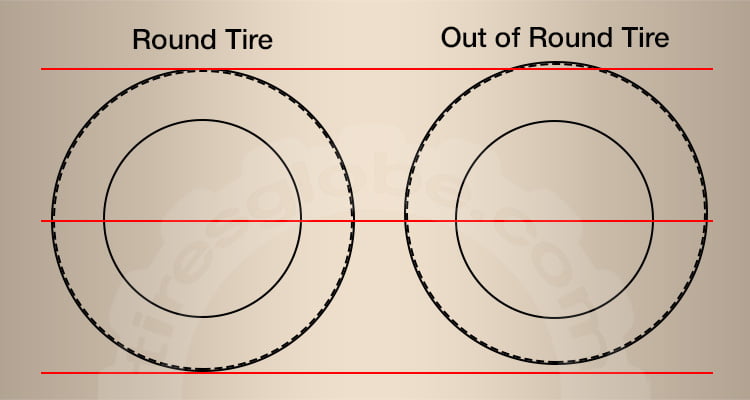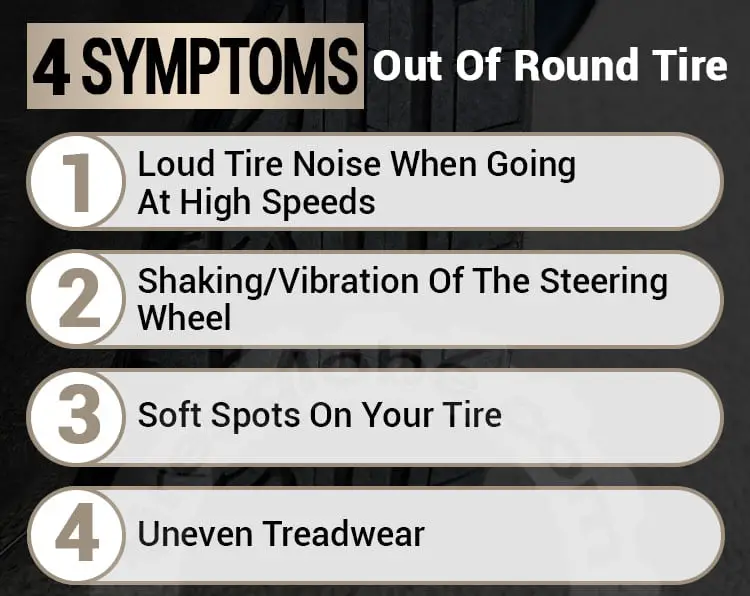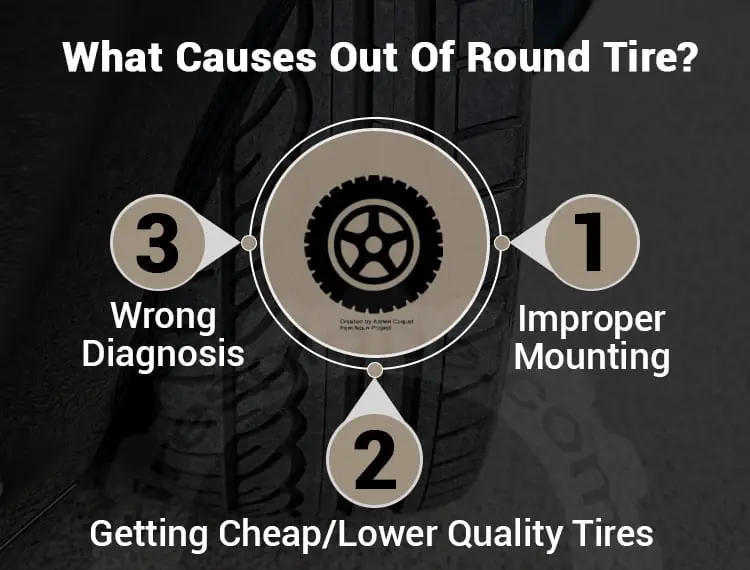Tires are round, and that’s a fact. However, that doesn’t mean your tire can’t lose that perfect round shape. This leads to what we call an “out-of-round tire.”
Having an out-of-round tire is not good news, yet it isn’t necessarily the end of that tire.
This article offers you all you need to know about out-of-round tires, their symptoms, how you can prevent them, and more. If that catches your attention, read on to know more.
What Is An Out Of Round Tire?
As the term “out of round” suggests, it refers to a tire that has lost its perfectly round shape. This imperfection throws the tire off balance. Tire runout is another term used to describe an out-of-round tire. Tire runout wouldn’t significantly affect your tire’s performance initially; however, you begin to notice symptoms as it gets critical. We will discuss this as we proceed.

What Are Types Of Tire Runout?
There are two forms of tire runout: the lateral and the radial runout. Below is an overview of these types of tire runout:
Radial Runout
This type of tire runout is the more common between the two. The radial tire runout deals with the distance between the center of the wheel and your tire’s tread. The distance between the wheel’s center and your tire’s tread should be exactly the same at every point outside your tire.
Radial runout has to do with distance discrepancies from point to point. Depending on the magnitude of the difference, the rotation of your tire will experience disturbance. This is because the radial runout will cause the wheel to bounce up and down, resulting in vibrations that you can feel from the steering.
Lateral Runout
Lateral runout deals with the center of the wheel and the tire’s tread edges. The more significant the lateral runout on the tires, the less stability its rotation will have. As a result, your tire will begin to move from side to side or wiggle.
To sum it all up, radial runout will cause your tire to bounce, while lateral runout will make it wiggle erratically.
Out Of Round Tire Symptoms
Having an out-of-round tire is unpleasant, but knowing its symptoms can help you avoid or prevent it. So what are the signs or symptoms to look out for when identifying tire runout?

- Loud tire noise when going at high speeds
- Shaking/vibration of the steering wheel
- Soft spots on your tire
- Uneven tread wear
These are some of the primary symptoms of an out-of-round tire. Keep in mind that if you feel vibrations in the seat, the issue originates from the rear. Also, if you feel these vibrations in the steering wheel, it’s a pointer that the problem is at the front.
What Causes Out Of Round Tire
Certain factors can cause your tires to become out-of-round. Tire runout can be caused by a lack of maintenance or manufacturing defects. Below is an overview of these causes.

- Getting Cheap/Lower Quality Tires
Cheaper tires may not go through many quality control processes. Because of this, manufacturers may use inferior molds, resulting in uneven wear on your tires. As mentioned earlier, uneven wear on a tire can cause a tire runout. Keep in mind that segmented molds are used to produce high-quality tires. This allows for much rounder tires.
- Improper Mounting
Having a perfectly round tire is excellent but isn’t good enough. Depending on whether or not the tire is mounted correctly, you may experience a tire runout. What we are saying, in essence, is that a perfectly round tire can become out-of-round if mounted improperly.
- Wrong Diagnosis
In the medical field, wrongly diagnosing a patient could lead to severe complications. The same goes for tires. Some tire problems have similar symptoms, which could mislead you if you aren’t careful enough. Let’s take, for instance, a perfectly round tire that may be imbalanced, causing it to shake. This is one of the symptoms of an out-of-round tire and could make you misdiagnose.
Similarly, a bent wheel may make a perfect round tire seem out of round. A separated tire will also mimic the symptoms of an out-of-round tire, causing it to shake violently. This shaking is because part of the tire’s outer tread cap has been separated from the tire’s body. As a result, tire failure follows quickly.
How Far Can A Tire Be Out Of Round Before It’s Bad?
Credit: Bruce’s Shop
While your tires won’t go out of commission once you notice the first symptoms, having an out-of-round tire isn’t something to take lightly. Your safety when driving should be a top priority, so you wouldn’t want to jeopardize that.
Driving on an out-of-round tire can be very uncomfortable as you will experience shaking, vibrations, wobbling, and more. Continuous driving on an out-of-round tire can result in tire failure. If this happens on the road, you may be in for a severe accident. There isn’t a given distance as far as a tire can be out-of-round before it’s bad. However, if you can avoid driving on an out-of-round tire, you should.
Can An Out Of Round Tire Be Fixed?
Once your tire is out-of-round, it can’t be fixed completely; however, you can manage it. How, you ask? You can manage an out-of-round tire by road force balancing your tire. Tire balancing is when additional weight is added to your rim in order to balance your tire’s weight. Doing this improves the ride quality of the tire.
A tire balancer will check for weak spots on your tire and rim, then put the strong part of the tire on the rim’s soft spot allowing for a smoother ride. However, this isn’t a fix as all it does is improve your faulty (out of round) tires. That being said, getting a new set of tires is the safest and most efficient fix.
Can I Drive With An Out Of Round Tire?
An out-of-round tire is as comfortable as its severity. This means that as time goes on and with constant drive, it becomes less drivable. Why? Vibrations will be more severe, tire wobbling and bouncing might increase unbearably.
While driving on an out-of-round tire isn’t a great idea, we understand that some situations can’t be helped. That’s why it is essential to know the symptoms of a tire runout. Knowing its symptoms will help you prepare ahead of time for a new set of tires before it gets too severe. During that period, you can drive carefully with an out-of-round tire. But do you know what’s even better than knowing its symptom? Your ability to prevent it.
How To Prevent Out Of Round Tire?
There are two major ways you can avoid having an out-of-round tire. You can prevent it by purchasing high-quality tires and by maintenance.
- Purchasing High-quality Tires
We understand money doesn’t grow on trees, but using that extra cash to buy quality tires will save you a lot of trouble in the long run. High-quality tires are less likely to have issues than low-quality tires. As stated earlier, segmented molds are used to produce high-quality tires, giving them a perfectly round shape.
- Proper Maintenance
Be it a high-quality tire or a low-quality tire, they must be adequately maintained. Tire maintenance goes a long way in increasing the lifespan of your tires. Proper care also ensures your tire remains in its round state, preventing a tire runout. This implies that you should inspect and rotate your tires at least after every 7,500 miles or six months.
Conclusion
Thanks to this informational guide, you now have all the relevant knowledge regarding out-of-round tires. That way, you won’t be caught off-guard with a tire runout. Always remember, your safety and the safety of others on the road are a top priority. Ensure that you keep your vehicle roadworthy at all times.
Read more: Broken Belt In Tire: Don’t Ignore Its Causes And Symptoms
Read more: Tire Wire Showing: How Long To Drive & How To Fix?

Thanks for the informative article.
bought Bridgestone turanza quiet track tires at Costco in N.J. One tire is clearly out of round as everything else was ruled out by Toyota dealer and Mavis at my expense. Costco refuses to replace this 2 week old tire. Learn from my experience. When it comes to tires learn from my experience and stay away from Costco Tire Centers and Bridgestone.